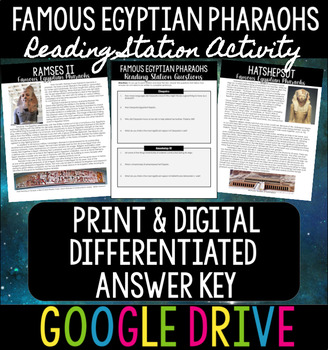Famous Egyptian Pharaohs Reading Stations & Campaign Poster
- Google Drive™ folder

What educators are saying
Description
Famous Egyptian Pharaohs Reading Stations, Campaign Poster, & Lesson Plan - Print & Digital, Answer Key, Rubric - Google Drive
This zero-prep, differentiated, fun activity covers famous Egyptian pharaohs. It is an excellent addition to your unit on Ancient Egypt and works great as a backup Sub-Lesson Plan! I like doing these activities because they get students up and moving.
This resource comes as a Google Drive resource. If you would like to print the resource material, you can do so. Simply go to "File," "Download," and "PDF" to save the resource as a PDF and print! PDFs are also provided of all the print options for your convenience.
⇣⇣⇣⇣⇣ Want to know more about what's in this resource? ⇣⇣⇣⇣⇣
The pharaoh's students will read about are:
- Cleopatra
- Ramses II
- Nefertiti and Akhenaten
- Amenhotep III
- Hatshepsut
- Ahmose I
- King Tutankhamun
2 differentiated options for students to complete at each station:
- Option A: Answer guided questions and complete a 10-sentence writing prompt at the end on who they believe is the greatest pharaoh
- Option B: Chart to fill out at each station and a 15-sentence writing prompt asking students to compare and contrast two pharaohs before determining which pharaoh is the greatest
Campaign Poster
Students will create their own campaign poster to induct their chosen pharaoh into the Greatest Pharaoh of All Time Hall of Fame. A sample poster on King Tutankhamun is given to help students visualize what to do.
Three options on how to use:
- Early finisher extension activity
- Individually or in groups when the writing section is complete
- Swap the writing section for the campaign poster
In addition to this, this resource also comes with the following:
- Teacher lesson plan
- Answer Key for the reading station activity (not pictured in preview)
- Writing rubric (not pictured in preview)
Best yet, all of these items are editable. If you need to change or adapt them to fit your curriculum or classroom needs, you can do that.
Thank you so much for viewing this product! If you like this product, you might be interested in some of my other Ancient Egypt products (including PowerPoints and readings), which you can find HERE.
Happy teaching! :)
Questions? Comments? Typos? Email me at thehistoryllama@gmail.com.
I love seeing my resources being used in classrooms. If you post about it on social media, don't forget to tag me on Instagram @thehistoryllama.





